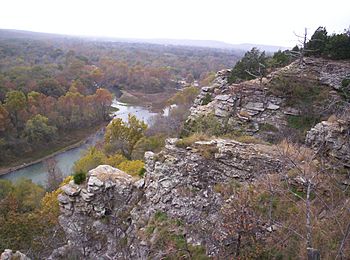Illinois River (Oklahoma) facts for kids
Quick facts for kids Illinois River |
|
|---|---|

The Illinois River, seen here in the upper stretches of Tenkiller Ferry Lake
|
|
| Country | United States |
| States | Arkansas, Oklahoma |
| Physical characteristics | |
| Main source | Ozark Mountains 35°51′08″N 94°17′23″W / 35.85222°N 94.28972°W |
| River mouth | Arkansas River 459 ft (140 m) 35°29′21″N 95°05′52″W / 35.48917°N 95.09778°W |
| Length | 98.8 mi (159.0 km) |
The Illinois River is a 145-mile long river in the United States. It flows through parts of Arkansas and Oklahoma. The Osage Indians, an early Native American tribe, called it Ne-eng-wah-kon-dah, which means "Medicine Stone River." Oklahoma has even named its part of the river a "Scenic River" because of its natural beauty.
This river is also famous from the 1961 book Where the Red Fern Grows by Wilson Rawls.
Contents
River History: Early Inhabitants & Uses
Long ago, a French explorer named this river "rivière des Illinois." He named it after the Illinois Confederation of Native American tribes. However, these tribes didn't usually live in this area.
The first known people here were ancestors of the Caddoans. They built the famous Spiro Mounds in Oklahoma. Later, in the 1700s, the Illinois River area was a hunting ground for the Osage Nation. Around 1800, Cherokee people started moving into the region.
In 1806, a U.S. Army Major named James Wilkinson reported seeing the river's mouth. By 1828, the Illinois River was officially set aside as a main waterway for the Cherokee people.
Illinois Confederation: Who Were They?
The Illinois Confederation was a group of Native American tribes. These included the Peoria, Miami, Wei, and Kaskaskia tribes. They all spoke similar languages and shared cultures. They were part of the larger Algonquin language family. The name Illinois comes from the Miami word Ilaniawaki, meaning "real or original ones."
Lake Tenkiller: A New Attraction
In 1947, people started building a dam on the Illinois River. This dam created Lake Tenkiller, which was finished in 1953. This new lake brought many tourists and fishermen to the area.
Since 1970, the Oklahoma Scenic Rivers Commission has looked after 70 miles of the river. This section flows through the Cookson Hills between Lake Tenkiller and the Arkansas border.
Illinois River Description: Where It Flows
The Illinois River starts in the Ozark Mountains in northwest Arkansas. It begins in Washington County, near Fayetteville. The river flows north, then northwest, passing under several highways.
It enters Benton County and continues west. It then turns southwest, flowing past Siloam Springs. The river then leaves Arkansas and enters Lake Frances in Oklahoma.
Journey Through Oklahoma
In Oklahoma, the river flows west, then southwest and south. It passes through the mountains of eastern Oklahoma. It flows by towns like Tahlequah. South of Tahlequah, it goes through the large Tenkiller Ferry Lake reservoir.
Finally, the Illinois River joins the Arkansas River near Gore. This is about 20 miles southeast of Muskogee. The river and its smaller streams drain an area of about 900 square miles. The town of Tahlequah, on its banks, was the end point of the sad journey known as the Trail of Tears.
Fun on the River: Tourism and Recreation
The Illinois River is a big draw for tourism in the area. In 1999, it was estimated that about 500,000 tourists visited the Oklahoma part of the river. This brought in about $9 million.
The upper part of the river, along with its smaller streams like Flint Creek and the Baron Fork, became a designated Scenic River in 1977. This area is home to many types of bass fish. It's also a very popular spot for people to go floating in the summer.
The lower part of the river, below the Tenkiller Dam, is a special trout stream. It's stocked with Rainbow and Brown Trout all year round. The biggest rainbow trout ever caught in Oklahoma was found in the cold water below this dam.
Environmental Challenges and Solutions
The Illinois River has been the center of a long-running disagreement between Arkansas and Oklahoma. Oklahoma has blamed Arkansas for pollution in the river. This pollution mainly comes from too much phosphorus from sewage and chicken farms.
Phosphorus Pollution: A Legal Battle
In 1987, wastewater from Fayetteville, Arkansas was found to be adding a lot of phosphorus to the river. Oklahoma sued Arkansas to stop this. The case went all the way to the U.S. Supreme Court in 1992. The court decided that states upstream (like Arkansas) must follow the water quality rules of states downstream (like Oklahoma).
In 2002, Oklahoma became the first state to set a specific number for how much phosphorus is allowed in its scenic rivers: 0.037 milligrams per liter. In December 2003, the two states reached an agreement. Arkansas agreed to cut phosphorus from its wastewater plants by 75% over ten years. However, this agreement did not cover pollution from chicken farms.
Improving Water Quality
A report in 1996 showed that too many nutrients were causing algae to grow in Lake Tenkiller. This was putting the lake in danger. The report said that phosphorus in the river needed to be cut by 40% to stop the lake from getting worse. To return the lake to its original condition, phosphorus needed to be cut by 80%.
Good news! The situation seems to be getting better. In 2015, the Oklahoma Water Resources Board reported that phosphorus levels were going down in the Illinois River and its streams on the Oklahoma side. The U.S. Environmental Protection Agency (USEPA) also released a water quality model for the river in 2015.
Wildlife and Nature Preserves
The J. T. Nickel Family Nature and Wildlife Preserve is the largest nature preserve near the Illinois River. It's located near Tahlequah, Oklahoma. In 2005, Elk were brought back to the preserve. This animal had not been seen in the Cookson Hills area for at least 150 years!


